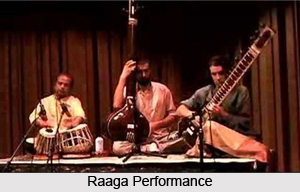 Raaga in performance follows a number of steps. When a musician performs a Raaga in Tala, he or she bases the performance around a fixed composition (Bandish), and then adds sections to it. After singing or playing the complete Bandish a few times, it may be shortened into a refrain, perhaps only the first line of the composition, or even only a few beats leading up to the downbeat of the Tala. This fore-shortened phrase usually shows a main feature of the Raaga and is called the Mukhra (face).
Raaga in performance follows a number of steps. When a musician performs a Raaga in Tala, he or she bases the performance around a fixed composition (Bandish), and then adds sections to it. After singing or playing the complete Bandish a few times, it may be shortened into a refrain, perhaps only the first line of the composition, or even only a few beats leading up to the downbeat of the Tala. This fore-shortened phrase usually shows a main feature of the Raaga and is called the Mukhra (face).
Following the Mukhra, the sections performed by the performer are determined both by the performance genre and the tradition that the performer represents, as well as the circumstances of the occasion. As they are composed on the spot, they will never be reproduced in performance the same way each time. These sections usually proceed in slow tempo and are a meditation on the melodic design of the Raaga. This kind of a slow beginning and gradual acceleration to a rapid conclusion is characteristic of the development of Raagas in Hindustani Music in general, and is known as the Badhat which means growth. The maintenance of the lure, feeling and design of the slow and steady growth of the Raaga is a highly prized and satisfying aspect of the performance of mature musicians.
The Raagas used in performance are many in number. Musicians say that the total number of Raagas number about 75,000 according to all the mathematical possibilities of note combinations and ordering. In any era, it seems that 500 or so Raagas are in circulation, but one musician might know half that many. A good musician may master the performance of only several dozen Raagas in his lifetime, although he might recognize many more by their sound.
This article is a stub. You can enrich by adding more information to it. Send your Write Up to [email protected]




